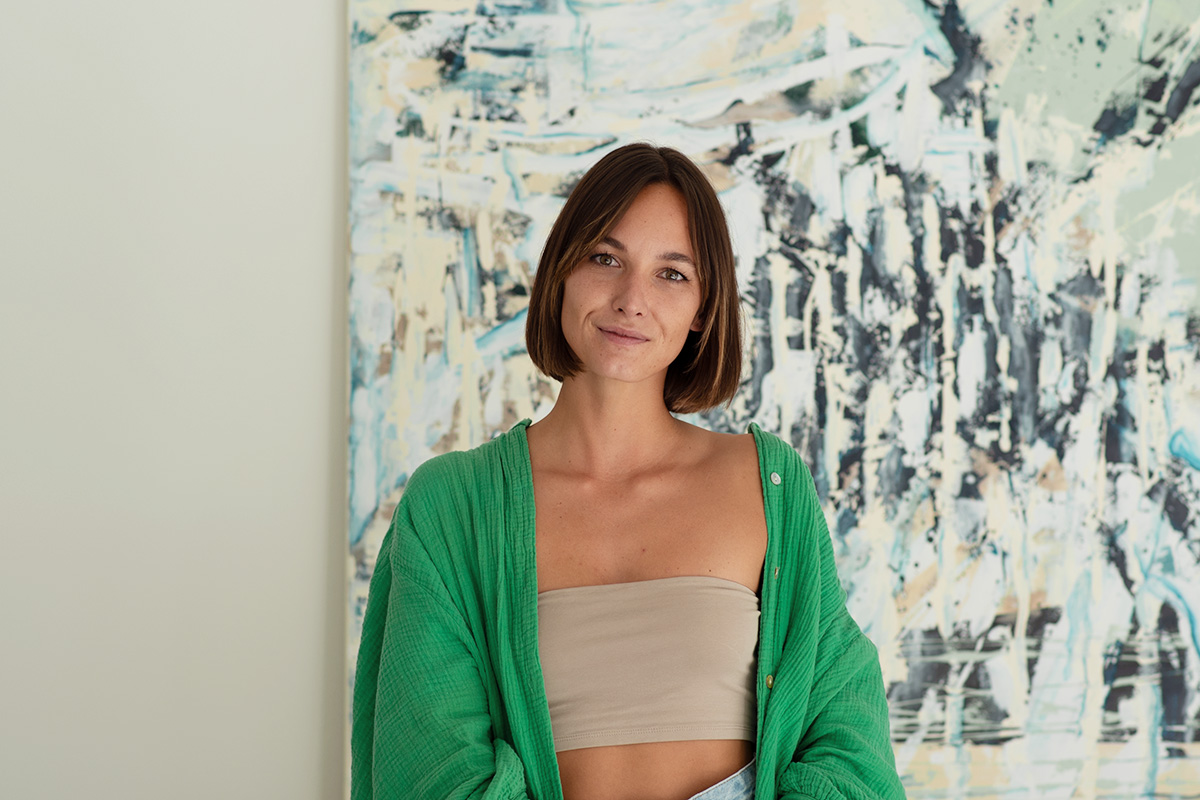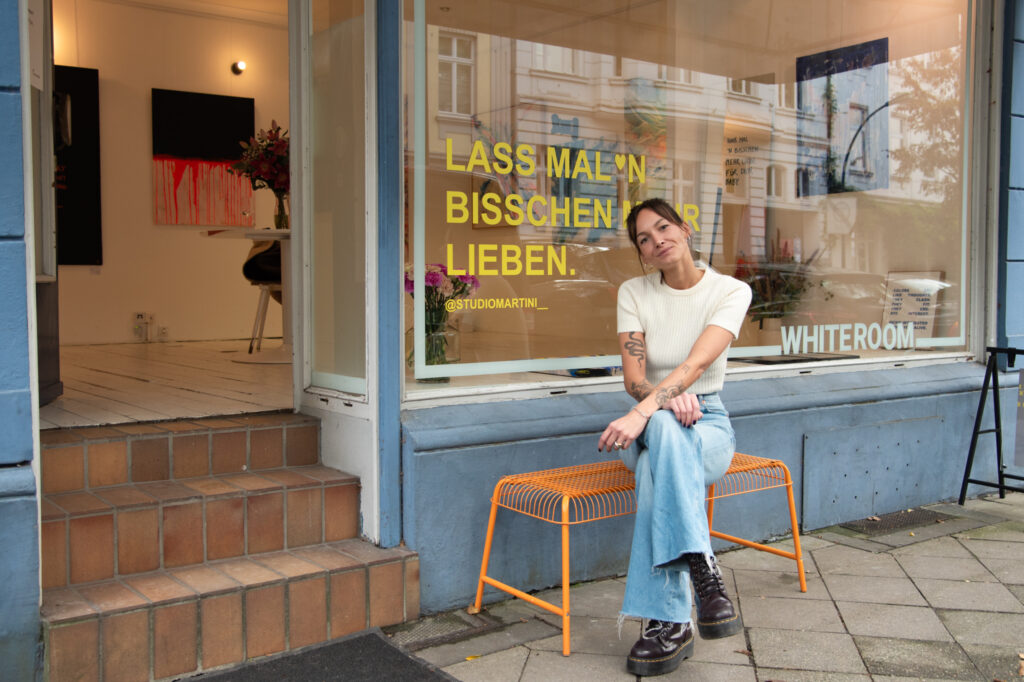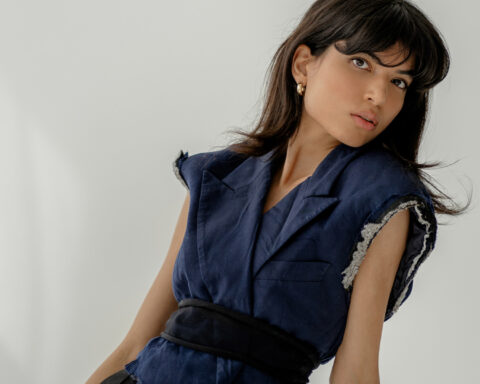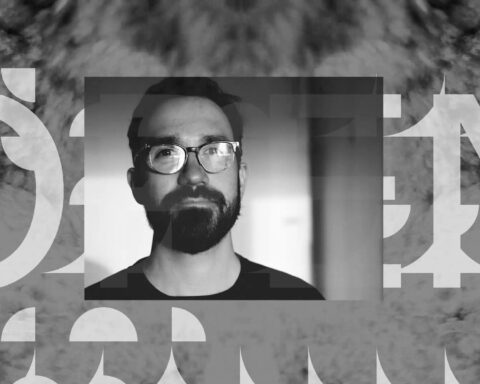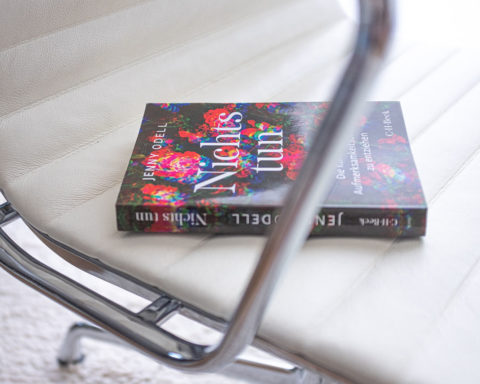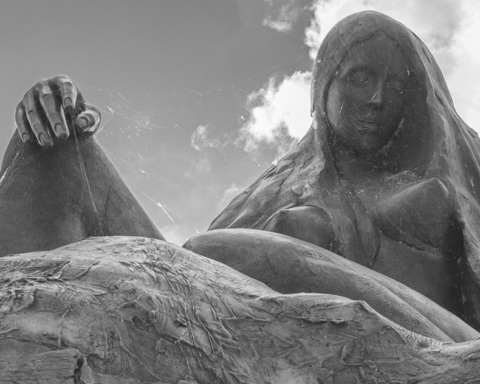Kim Isabell Martini ist lange Jahre in der Modebranche angestellt und entdeckt während der Coronakrise ihre Liebe zur Malerei. Im Frühjahr hat sie ihre Arbeiten erstmals in Düsseldorf der Öffentlichkeit präsentiert.
Ich habe die Düsseldorfer Künstlerin im BECYCLE Düsseldorf getroffen, wo einige ihrer Bilder ausgestellt sind und durfte mit ihr über Kreativität, Sichtbarkeit und die Vereinbarkeit von Kunst und Festanstellung sprechen. Was die junge Künstlerin bewegt und welche Pläne sie für die Zukunft hat – lest selbst.
Was hat Dich dazu bewegt Künstlerin zu werden?
Ich bin ein sehr visueller Mensch und lege großen Wert auf Kreativität – diese Fähigkeiten kommen meiner Arbeit in der Mode sehr zu Gute. Als 2020 Corona kam und ich in den Kurzarbeits-Phasen ungewohnt viel Zeit zu Hause hatte, habe ich begonnen zu malen. Klar hat das nicht direkt zu tollen Ergebnissen geführt, aber ich habe schnell gemerkt, wie sehr es mich entspannt. Ich blieb dran und verbesserte mich. Heute würde ich sagen, dass meine Liebe zur Kunst wahrscheinlich schon in mir angelegt war, als ich früher stundenlang zusammen mit meiner Oma gemalt habe. Vor zwei Jahren durfte diese Liebe dann endlich wieder zum Vorschein kommen.
Was zeichnet Deine Werke aus?
Meine Bilder leben vom Zusammenspiel ihrer Farben. Aus der Ferne sind sie sehr stimmig und strahlen eine gewisse Ruhe aus. Geht man etwas näher heran, können sie trotzdem laut und unruhig erscheinen. Die Harmonie zwischen diesen Zuständen zu finden und gleichzeitig beide zuzulassen, finde ich sehr bewegend. Ich liebe es zu sehen, wie die Farben sich gegenseitig unterstützen und hervorheben und in jeder und jedem Betrachtenden etwas anderes auslösen und inspirieren.
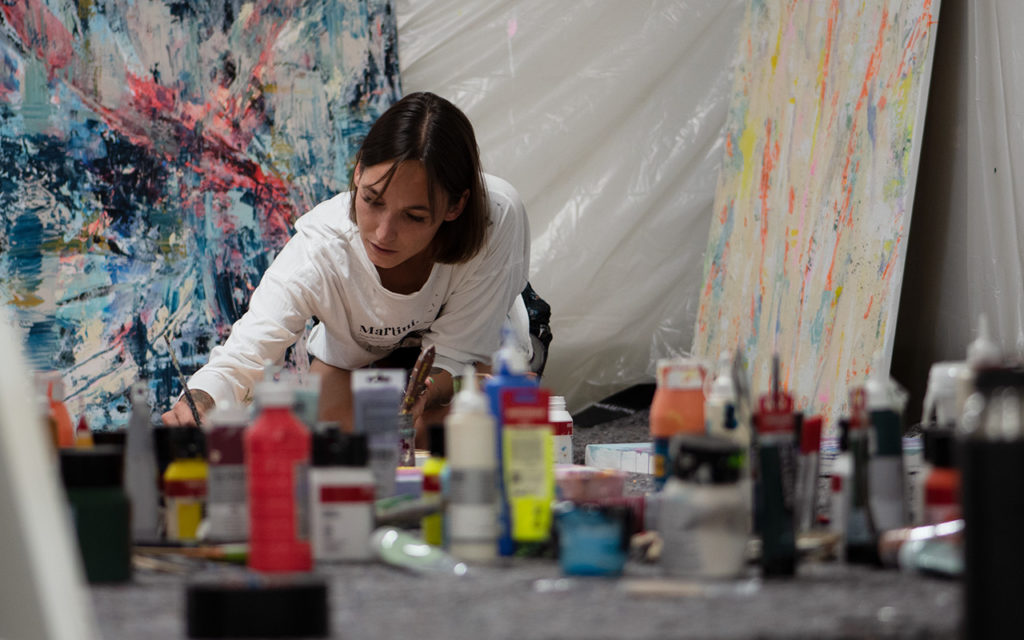
Was treibt Deine künstlerische Arbeit an?
Ein wichtiger Faktor für meine Arbeit als Malerin ist die Fotografie. Wenn ich mich in der Stadt oder in der Natur bewege, fange ich immer wieder interessante Momente ein, die meine Aufmerksamkeit auf sich ziehen. Über die Kamera spiele ich mit Lichtstimmungen und -effekten und entdecke ungewöhnliche Formen und Farben. Manchmal sind es nur kleine Alltagseindrücke, die neue Ideen in mir wecken oder mich an etwas Vergangenes erinnern. Durch die Linse sehe ich die Welt einfach mit anderen Augen. Dieser veränderte Blick beeinflusst auch meine Malerei.
Du arbeitest hauptberuflich in der Wirtschaft? Wie vereinbarst Du Beruf und Berufung?
Das Kreative mit dem Wirtschaftlichen zu verbinden, ist manchmal schwierig. Als Kreative:r wird man von ökonomisch getriebenen Menschen oft nicht verstanden, muss sich erklären und dann kompromissbereit sein. Gleichzeitig ist es gut, beide Seiten zu kennen, um sich nicht gedankenlos einer Sache hinzugeben, die zwar glücklich macht, aber am Ende nicht mit der Realität vereinbar ist. Auch hier ist Harmonie ein wichtiger Faktor.
Im Alltag arbeite ich sehr konzeptionell und daher eher zukunftsorientiert. Bei meinen Bildern ist das anders. Wenn ich sie übergebe, erlebe ich unmittelbar, wie ich anderen eine Freude bereite und das ist es, was mich antreibt.
Auch sonst lassen sich Beruf und Malerei für mich super vereinen. Die Kunst schenkt mir die Energie, die ich für meinen Alltag benötige. Sie ist für mich ein perfekter Ausgleich und bringt mich, ganz egal, was vorher passiert ist, aus meinem Kopf in den Moment. Ich bin dann einfach leer und ganz bei den Bildern. Das ist ein wunderbares Gefühl.
Kannst Du Dir vorstellen, langfristig Deine Leidenschaft zum Beruf zu machen?
Natürlich ist es immer der Traum, jeden Tag selbstbestimmt das tun zu können, was man liebt und ständig im Austausch mit anderen Kreativen zu sein.
Ein wesentlicher Faktor für den Erfolg einer Künstlerin bzw. eines Künstlers ist die Sichtbarkeit. Warum findet man Dich kaum im Internet?
Wenn ich mich einem Thema widme, dann mache ich es gerne richtig und durchdacht. Deshalb habe ich sehr viel Respekt davor, aktiv auf mich aufmerksam zu machen, aus Angst durch die Vollzeit-Anstellung nicht 100% geben zu können.
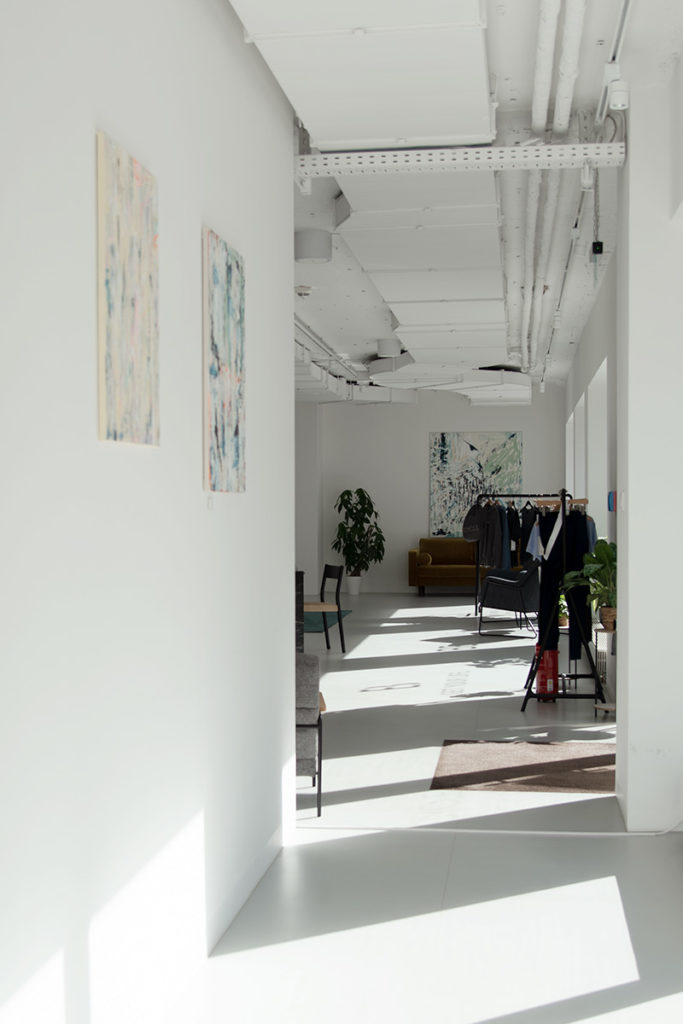
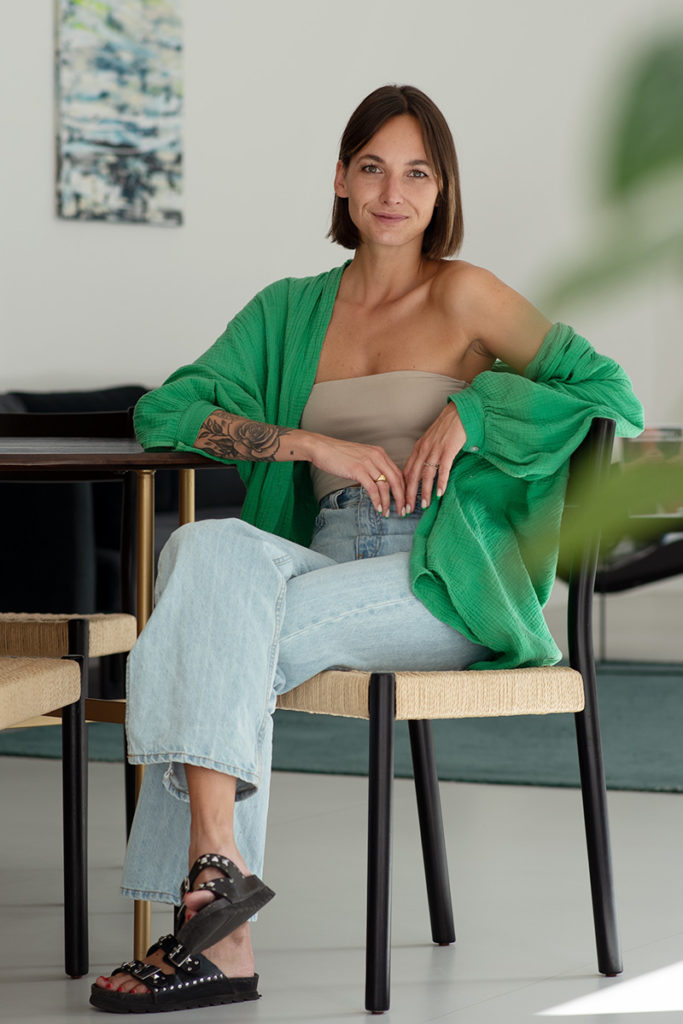
Ich glaube es ist schwer in der Kunstszene Fuß zu fassen, weil es einfach unglaublich viele tolle Künstler:innen gibt. Selbst lokal ein bisschen bekannter zu werden ist mit viel Arbeit verbunden. Bei meiner ersten Ausstellung im BECYCLE in Düsseldorf habe ich außerdem gemerkt, wie fordernd es sein kann, im Fokus der Aufmerksamkeit zu stehen. Ich möchte hier meinen eigenen Weg finden und mich vor allem nicht verstellen müssen, um erfolgreich zu sein. Und wenn die Suche danach ein bisschen mehr Zeit in Anspruch nimmt, dann ist das einfach so.
Wie finden Menschen dann Deine Kunst?
Bilder sind etwas sehr persönliches, weil sie gleichzeitig etwas über denjenigen verraten, der sie malt und denjenigen, der sie kauft. Deswegen ist es gut, auch die Person hinter den Bildern kennenzulernen. Während meiner Ausstellung habe ich gemerkt, dass die Menschen viel interessierter an meiner Kunst sind, wenn sie etwas von mir erfahren, deswegen habe ich auf Instagram einen Kanal eingerichtet, über den ich immer mal wieder Einblicke in den Prozess des Malens und in kleine Ausschnitte meines Lebens gebe (@isabellmaritni) und einen, auf dem ich meine Bilder zeige, die zum Verkauf stehen (@kimisabellmartini).
Auch wenn meine Accounts noch sehr klein sind und ich wenig poste, bieten sie schon heute eine tolle Plattform für mich, um gefunden zu werden und Feedback zu bekommen. Viele Kund:innen werden über Social Media auf mich aufmerksam und stellen mir Fragen zu meiner Arbeit. Mir ist es wichtig, möglichst authentisch und nahbar zu sein und als jemand wahrgenommen zu werden, mit der und mit deren Kunst man gerne in Kontakt tritt.
Wie sieht der Prozess hinter Deinen Bildern aus?
Wenn ich mich einem neuen Bild widme, dann ist die Vorstellung an eine bestimmte Farbrichtung meine Grundlage. Der Rest entsteht im Prozess: Wie wirken die Farben zusammen, wie ist meine Stimmung als Künstlerin. Bei Auftragsarbeiten denke ich zuerst an die späteren Besitzer:innen, berücksichtige ihre Farbwünsche und male dann einfach drauf los.
Ich kann nur arbeiten, wenn ich mich wirklich danach fühle und möchte mich im Prozess des Malens nicht unter Druck setzen lassen, weil sonst die Qualität der Bilder darunter leidet. Bisher sind meine Auftraggeber:innen super verständnisvoll, weil sie verstehen, dass Kreativität Zeit und Raum braucht.
Die Titel meiner Bilder sind die Nummern der Abfolge, in der ich sie gemalt habt. Mir ist es wichtig, Menschen die Freiheit zu lassen, sie selbst zu interpretieren und dabei möglichst wenig beeinflusst zu werden. Viele suchen zwar nach Antworten und vorgegebene Interpretationen, aber ich finde es viel spannender, wenn Spielraum für eigene Gedanken bleibt.
Wo siehst Du Deinen zukünftigen Platz in der Kunstwelt?
Im Anschluss an meine Ausstellung habe ich einen Workshop für Kinder angeleitet. Das hat mir super viel Spaß gemacht, gerade weil es nicht darum ging, lange zu erklären und besondere Techniken zu vermitteln. Ich hatte mir vorgenommen, meine Erlebnisse mit der Malerei weiterzugeben und jede:n zu motivieren, einen eigenen Weg zu finden, um seiner oder ihrer Kreativität freien Lauf zu lassen.
Ich könnte mir gut vorstellen, diese Form von Workshops zukünftig häufiger und auch für Erwachsene anzubieten. Wir vergessen uns oft im Alltag und sind gestresst. Ich würde gerne mehr Menschen dafür begeistern, wie befreiend es sein kann, einfach loszulegen und sich dem Malen hinzugeben, ohne darüber nachzudenken, was dabei wohl herauskommen wird. Es ist sehr besonders, etwas mit den eigenen Händen zu schaffen.
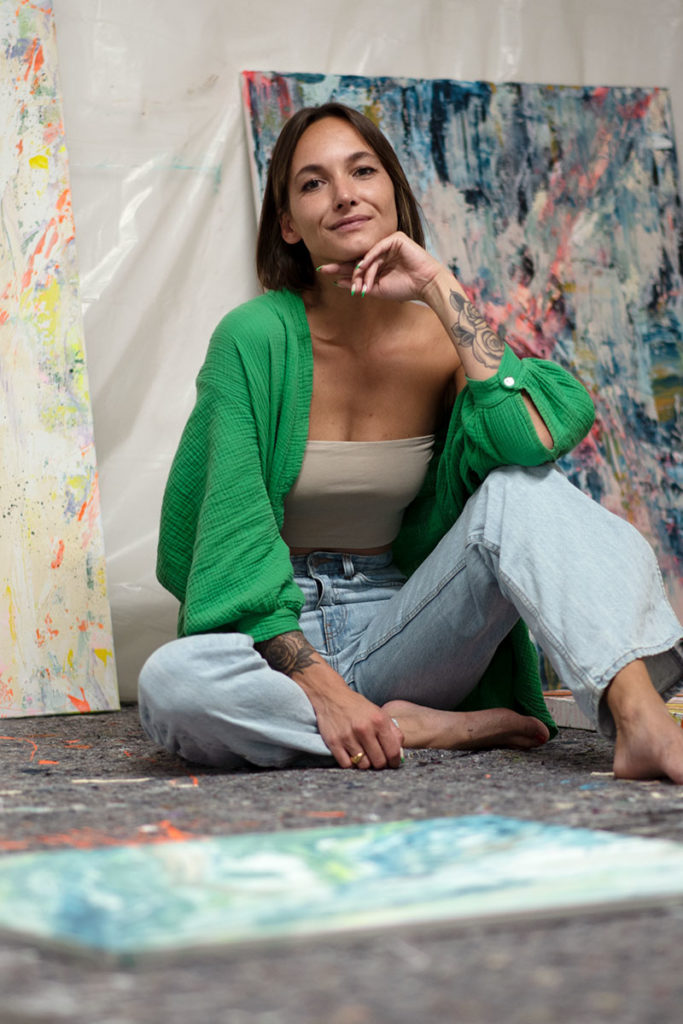
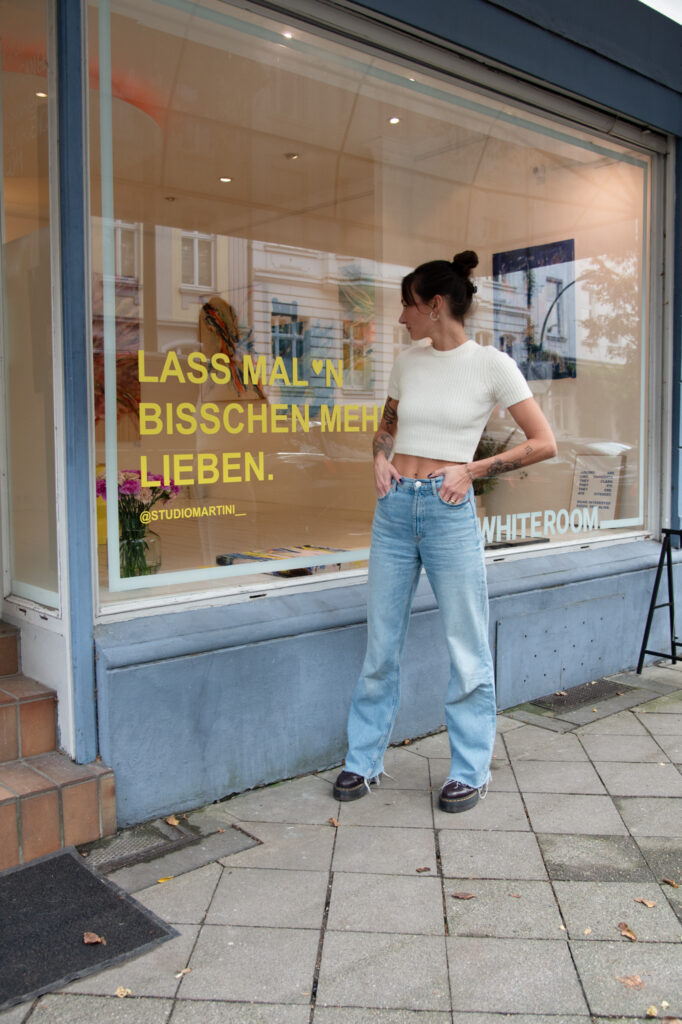
Außerdem träume ich davon, irgendwann ein kleines Atelier zu haben, in dem ich malen und meine Werke präsentieren kann. Ein Ort wo Freunde zu Besuch kommen, mir zuschauen und Abends auf einer Bank vor der Tür zusammen mit mir Vino trinken.
Nachtrag: Im Herbst 2023 mietete sich Kim den Whiteroom in Düsseldorf Flingern und erfüllte sich damit für eine Woche den Wunsch vom eigenen Atelierspace. Seitdem konzentriert sie sich hauptberuflich auf ihre Kunst. Ihre Arbeiten zeigt und verkauft sie über ihre Website www.studiomartini.de.
Creativity needs time and space
Kim Isabell Martini has been employed in the fashion industry for many years and discovered her love of painting during the Corona crisis. In spring, she presented her work to the public for the first time.
I met Kim at BECYCLE Düsseldorf, where some of her paintings are exhibited, and had the chance to talk to her about creativity, visibility and the compatibility of art and permanent employment. What moves the young artist and what are her plans for the future? Read for yourself.
How did you become an artist?
I’m a very visual person and love creative work. When in 2020 Corona came along, I spend an unusual amount of time at home due to reduced working hours and started painting. Of course, I didn’t produce great results straight away, but I quickly realised the calming effect the work had on me. So I kept at it and, over time, improved. In the end, I guess my love for art was always a part of me as I used to spend hours and hours painting with my grandma when I was a child. Two years ago, this love was finally allowed to emerge again.
What characterises your works?
My paintings live from the interplay of their colours. From a distance they seem very coherent and radiate a certain calm. If you get a little closer, they can appear loud and restless at the same time. Finding the harmony between these states and allowing both to be moves me very much. I love to see how the colours support and highlight each other and trigger and inspire something different in each and every viewer.
What drives your artistic work?
An important factor for my work as a painter is photography. When I move around in the city or in nature, I always capture interesting moments that catch my attention. Through the camera I play with light moods and effects and discover unusual shapes and colours. Sometimes it’s just small everyday impressions that awaken new ideas in me or remind me of something in the past. Through the lens I simply see the world with different eyes. This changed view also influences my painting.
You work full-time in business. How do you reconcile your profession and your vocation?
It is sometimes difficult to combine the creative with the economic. As a creative person, you are often not understood by economically driven people, you have to explain yourself and then be ready to compromise. At the same time, it is good to know both sides in order not to thoughtlessly indulge in something that makes you happy, but in the end is not compatible with reality. Harmony is an important factor here.
In everyday life I work very conceptually and therefore rather future-oriented. With my paintings it is different. When I hand them over to my clients, I immediately experience the joy they bring to them and that is what drives me very much.
In other ways, too, I find it easy to combine work and painting. Art gives me the energy I need for my everyday life. It is a perfect balance for me and takes me out of my head and into the moment, no matter what has happened before. I am then simply empty and completely with the pictures. That is a wonderful feeling.
Can you imagine turning your passion into a profession in the long term?
Of course, it is always a dream to be able to do what you love every day in a self-determined way and to be in constant exchange with other creative people.
An essential factor for the success of an artist is visibility. Why can you hardly be found on the internet?
When I dedicate myself to a subject, I like to do it properly and thoughtfully. That’s why I have a lot of respect for actively drawing attention to myself as I fear not to be able to give 100% due to full-time employment.
I think it’s hard to get a foothold in the art scene because there are so many great artists out there. It takes a lot of work to become known, even locally. At my first exhibition at BECYCLE Düsseldorf, I also noticed how challenging it is to be the center of attention. I want to find my own way here and above all, I don’t want to pretend something I’m not, simply to be successful. If that searching process takes a little more time, that’s just the way it is.
How do people find your art then?
Paintings are something very personal because they reveal something about the person who paints and the person who buys them. That’s why it’s good to get to know the person behind the pictures. During my exhibition, I noticed that people are much more interested in my art when they get to know something about me, which is why I set up a channel on Instagram where I occasionally give insights into the process of painting and small parts of my life (@isabellmaritni) as well as one where I show my paintings that are for sale (@kimisabellmartini).
Even though my accounts are still very small and I don’t post much, they already offer a great platform for me to be found and get feedback. Many customers find me through social media and ask me questions about my work. It is important to me to be as authentic and approachable as possible and to be perceived as someone with whom and with whose art people like to get in touch.
Is there a certain process behind your art?
When I dedicate myself to a new painting, the idea of a certain colour direction is my basis. The rest happenes in the process: how do the colours work together, what is my mood as an artist. With commissioned works, I first think of the future owners, take their colour wishes into account and then just paint away.
I can only work when I really feel like it and I don’t want to be put under pressure in the process of painting, because otherwise the quality of the pictures suffers. So far my clients have been super understanding because they know that creativity needs time and space.
The titles of my paintings represent the sequence in which I painted them. It is important to me to give people the freedom to establish their very own interpretations. I want to influence them as little as possible. I am aware, that many people are looking for answers and predetermined interpretations, but for me, it seems much more exciting to leave room for one’s own thoughts.
Where do you see your future place in the art world?
After my exhibition, I led a workshop for children. I had a lot of fun doing that, especially because it wasn’t just about explaining things or teaching special techniques. I wanted to pass on my personal experiences with painting, motivate everyone to find their own way and give free rein to the childrens creativity. I could well imagine offering this kind of workshop more often in the future and also for adults. We often forget ourselves in everyday life and are stressed. I would like to inspire people to see how liberating it can be to just go ahead and paint without thinking about what will come out of it.
I also dream of having a small studio one day where I can paint and present my work. A place where friends come to visit, watch me and drink vino with me in the evening on a bench in front of the door.
